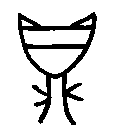I Ching, Yijing or Zhou Yi
"Oracle of the moon": © 2000 LiSe
 Yi Jing, Oracle of the Moon
Yi Jing, Oracle of the Moon

The image of hexagram 50
Dĭng
What does it mean, 'inner' and 'outer trigram' (popup)
Xún below Lí: when the inner law xún manifests itself though the outer clarity of Lí, things become right and according to standards. The well ordered state of a wise emperor, or the strict hierarchy and set of rules of a criminal gang. Both 'standardized' by their laws. The wise ruler will divine and submit to the will of heaven in order to align his laws and choices with the spirits and the ancestors. Which is where the gang falls short, their laws are based on greed and power.

Ideogram of the hexagram name: a three-legged (bronze) cauldron. Nine cauldrons were the symbol of the reign of the emperor. Dĭng is cognate with zhēn (divination), zhèng (regular), dīng (fourth heavenly stem) and Dìng (asterism to set right). All of them have to do with setting the times and measures right. Temples along the true-north line, seasons at their right time, measures without exceptions. See this page about Ding and setting right.
The Great Image says: Above wood there is fire: the cauldron. The noble one corrects the situation to solidify fate.
Hex.50 is the contrast of 3, which is about beginning from scratch.
Hex.50 is the state with its rules and laws, the organized enterprise, the ecological balance or the well-oiled dedicated group where everyone contributes to the whole, like the 9 feudal lords who pledged allegiance to the ruler, each presenting a bronze Ding.
Above wood there is fire: the cauldron. The noble one corrects the situation to solidify fate.
Fate is not something coming from elsewhere. Your fate will be created by who you are, what you do, where you happen to be. So be careful with the things you can change, make sure you change them in the best way possible.

